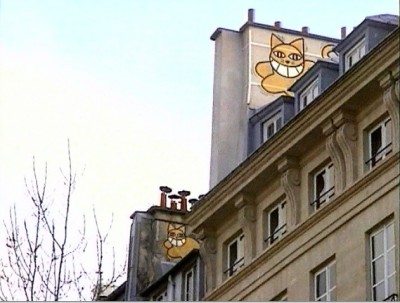
At first glance, Jean-Luc Godard's Contempt may have seemed to the international art cinema audience of the 60's a first step towards commercialism for the previously radical director. The French theatrical poster borrowed its look from the sensational Hollywood advertisements of the time: one of the film's subjects, the gorgeous Brigitte Bardot, is painted prominently across the front, giving her the implication of a radiant Hollywood starlet rather than her Godardian counterpart - a cynical, utterly impenetrable woman. Contempt also had direct ties with America, both in the casting of Jack Palance as the hot-headed producer and in the involvement of American executives who asked Godard out of marketable interests to include Bardot's behind at least once in the film, a request that Godard did indeed heed in the opening minutes of the film. Although they wanted more than his brazenly dispassionate observation of Bardot's body while her playwright husband selflessly lauds it - a scene in which red and blue color filters are added with a seeming lack of motivation - Godard's story, based off of Alberto Moravia's A Ghost At Noon, does not call for any more sensuality as its central couple steadily disconnects.
Palance's character, Jeremy Prokosch, a stern American producer who must constantly speak through a cute interpreter, hands Paul Javal (Michel Piccoli in his first role), a failed, artistically flimsy French playwright, the job of commercializing a film script for The Odyssey which is to be directed by Fritz Lang. Prokosch does so with determination, taking Paul to see Lang (played by himself) in his studio and then capping off the request by inviting Paul and his wife for lunch at his place. Paul is mildly reluctant about the whole affair, in part because he wants to attempt to balance his artistic integrity and the prospect of payment but also because upon finishing lunch with the producer, he finds his wife Camille (Bardot) out of love with him. Is it because he took the job so spontaneously? Could it have been his offhand stab at flirtation with the producer's interpreter? Or is it something that perhaps he was entirely oblivious to?
This confusion is something that is frequently felt in the males of Godard's films, who are always artistic, aloof, and quietly apprehensive. It's always tempting to read these characters as Godard's onscreen surrogate, with their respective partners as his wife of the time. Little else would explain the aching honesty and firm handle of the thirty minute disintegration between Paul and Camille in the high-rise apartment that follows their lunch with Prokosch. Jonathan Rosenbaum observed a likeness to Antonioni in the film, and nowhere is that comparison more apt here. Camille shifts emotions like a chameleon in the scene, first calmly expressing discontent to Paul, then teasing him with love that doesn't exist, and finally growing cold and non-confrontational, pushing Paul into feelings of deep confusion and anger. The apartment, with its inhospitable, hygienic look - blank white walls, an occasional beaming red couch, and utterly underdeveloped design (there is a door that appears to have glass in the middle but proves to just be a wooden frame) - act as a perfect architectural counterpart to the unfolding drama. Godard shoots in long, distant takes that pan around the flat, usually leaving only one character in the frame while obscuring the other behind the empty modern walls. The labyrinthine structure of the interior acts like a funhouse, baffling Paul while the object he attempts to become close to seems to be perpetually receding into the layers of white. Not only is the scene dramatically involving, but it is also choreographed with deftness.

Godard's narrative flow isn't exactly polished, because the apartment scene lasts for so long it seems for a moment that it may even conclude the film. However, the two go to the pastoral shores of Capri to meet Lang and the producer to work on The Odyssey. In doing so, Godard makes an acute statement about the public and the private. Camille's behavior takes a visible leap from talky and incomprehensible to absolute silence and impenetrability. Here is where she makes her boldest statement of contempt, and although the beautiful setting seems ideal for love, Godard's camera, which remains restrained, absent of the frenetic visual style he introduced with Breathless, and almost completely without close-ups, emphasizes the irresolvable damage done to the marriage. This dichotomy between the public and private display of emotions also mirrors Paul's uncertainty about his art and whether he's selling out. He too oscillates between expression and stifling. Therefore, Godard's stance is that when cinema becomes an industry instead of an art, it interrupts on a personal level, a sentiment that is echoed in a shot of Paul and Camille seated on opposite sides of an aisle at a theater with a photographer placed in between, and also in the absurdly frequent interjections of Georges Delerue's overtly tragic and "cinematic" score.
Contempt is shot in CinemaScope and Technicolor by one of Godard's most noted collaborators, Raoul Coutard. Godard was not entirely keen on shooting the film in this format, after the bulk of his previous films were so much of the opposite, but in truth it was a blessing in disguise. The splashy colors in the film and the expansive, eye-catching compositions foreshadow much of Godard's subsequent work, especially Pierrot Le Fou, also lensed by Coutard. It is a film that sticks out in Godard's oeuvre for its uncharacteristic restraint and its focus on dissolution that owed a great deal to his influences. Also, it is one of his more deceptive films on the surface; despite the whiff of commodification it hinted at, it is actually a thoroughly rewarding art piece with a tapestry of visual and conceptual ideas.








